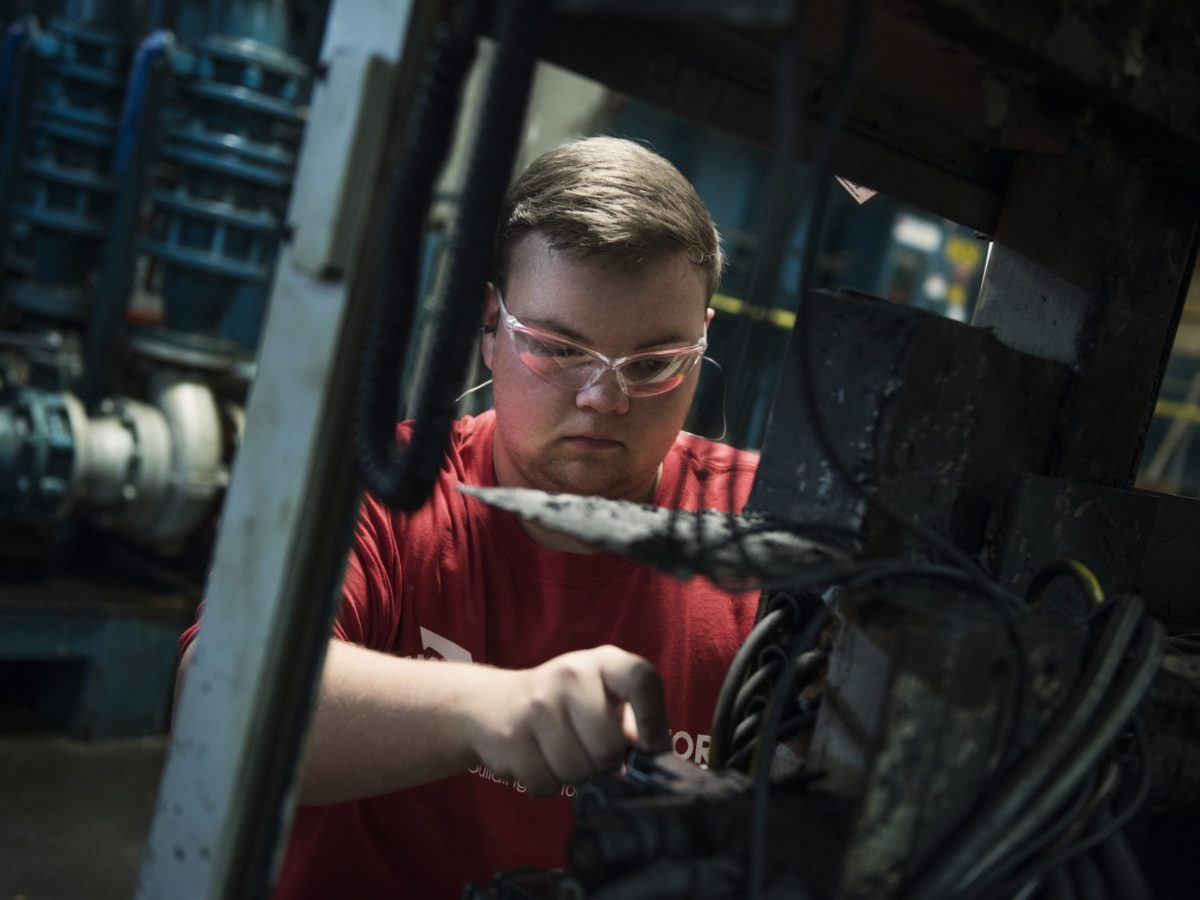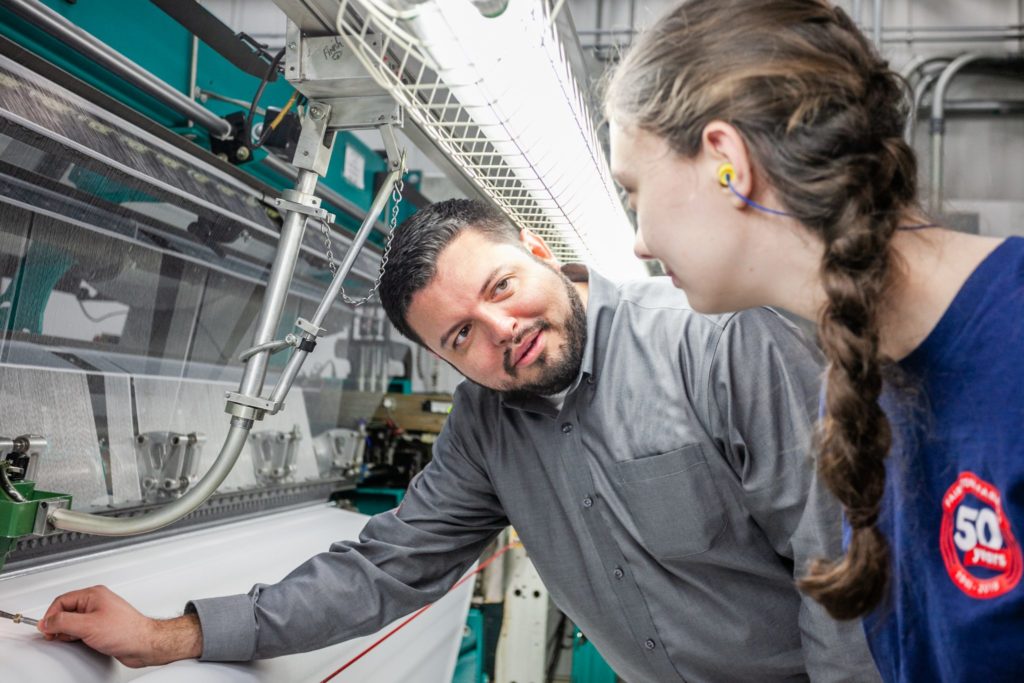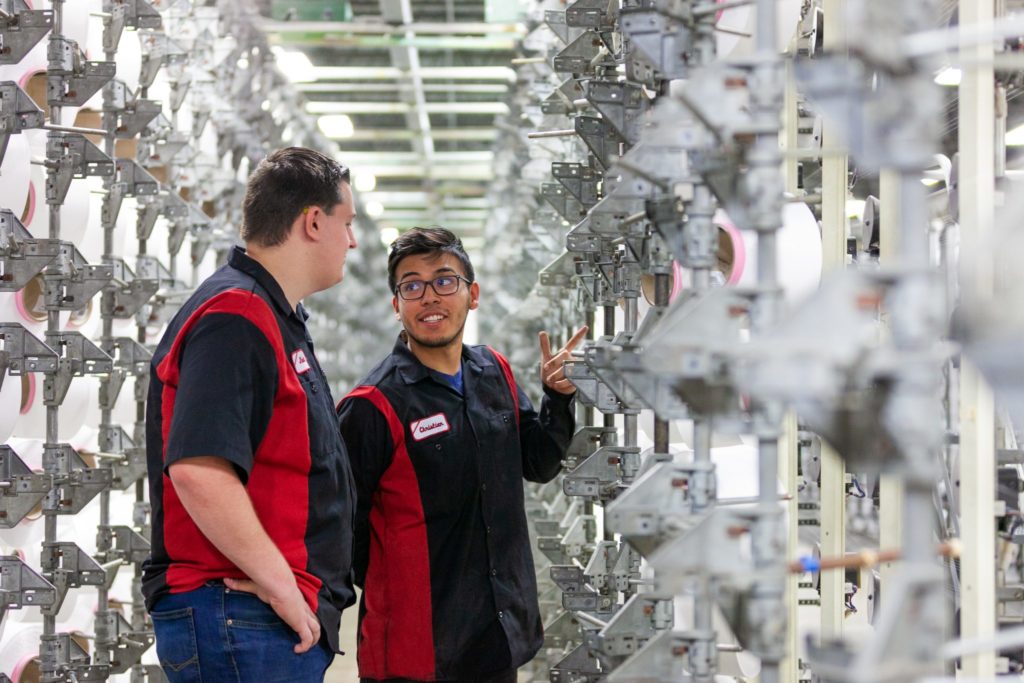
|
|
North Carolina’s community college system wrested control of the state’s apprenticeship programs from the Commerce Department four years ago. Since then, participation has doubled and a stalled program has become a national leader in workforce training.
How’d they do it? In large part, by leveraging on-the-ground connections that the state’s 58 community colleges have, but that the Commerce Department lacked. Take a recent example from Alamance County, which sits in the central part of the state between Greensboro and Raleigh. Just last week, the mother of an apprenticeship coordinator at the local community college was chatting with an acquaintance about her daughter’s job. The acquaintance, an HR director at a cigarette manufacturer, said she wished her company had apprentices. Hours later, the chairman of Alamance Community College’s youth apprenticeship program was pitching the program to the manufacturer.
That kind of creativity and local know-how has proven especially adept at bringing in and training new workers for industries currently dominated by now-retiring Baby Boomers. Employers report getting back $1.70 for every dollar they spend on apprenticeships, and students are attracted by clear career pathways and the opportunity to have the cost of their education covered.
“I can go anywhere in the country and find a job tomorrow.”
Justin Padmos, former youth apprentice and now a journeyworker in high-tech manufacturing
North Carolina overhauled its approach to apprenticeships at a time when they were getting increased attention nationally as a way to prepare students for high-demand “middle-skill” jobs, which require some postsecondary education but less than a bachelor’s degree. President Biden has emphasized that nine in 10 of the jobs that would be created by massive new federal spending on infrastructure likely wouldn’t require a four-year degree. And the administration has specifically endorsed legislation that would fund one million new federally registered apprenticeships to help fill some of those roles.
Across the country, apprenticeship programs remain small compared to other degree pathways, and participant diversity is a challenge, given apprenticeships’ long-standing association with the trades and other fields dominated by white men. That’s still true in North Carolina, too — but the state’s experience shows that, while apprenticeships aren’t a panacea, they can be a critical component of efforts to increase economic mobility and train the new talent companies need.
“As employers face a tight labor market now — and anticipate an ever-evolving labor market in the coming decades — hiring alone won’t be enough to source and retain productive workers,” says Deborah Kobes, senior director at JFF, a national nonprofit that works to align workforce and education systems. “Registered apprenticeships will be a critical strategy for employers to bring on employees who can contribute to their company right away, while growing into their most skilled and in-demand positions.”
Evolving approach to apprenticeships
The old model
ApprenticeshipNC, the state agency that certifies apprenticeships and handles other administrative tasks, once fell under the Department of Labor and later, the Department of Commerce. During one lean period when the state cut the program’s budget, the agency went as far as charging companies to register for their apprenticeship programs — “the bottom point,” says Scott Ralls, former president of the state community college system and now president of Wake Technical Community College in Raleigh.
In 2016, the last year ApprenticeshipNC was under Commerce Department supervision, there were 5,161 apprentices statewide. A year later, N.C. legislators voted to move the program to the community college system, believing administrators and instructors at the 58 campuses were far better equipped to understand the needs of local employers — and far better positioned to align students’ skills and credentials with workforce needs. Apprenticeships rose to 12,244 in 2020, according to the most recent report from ApprenticeshipNC. What’s more, the number of youth apprentices — students recruited by community colleges while they’re still in high school — nearly quadrupled, to 587 participants statewide.
A substantial proportion of apprenticeships are still run directly by major employers, but much of the new growth has been in programs run by or otherwise affiliated with community colleges. That allows them to embed associate degrees and other college credentials into the on-the-job training apprentices receive.
North Carolina is one of 24 states with a centralized, state-managed apprenticeship program, according to the Education Commission of the States. And it’s one of nine states, plus the District of Columbia, that require apprenticeship programs to have an educational component.
Explaining the growth
Before 2017, ApprenticeshipNC didn’t — and still doesn’t — recruit employers or potential apprentices. Its primary function was — and still is — managing the bureaucracy. But joining the community college system resulted in an exponential increase in the number of apprenticeship evangelists across the state. Faculty and staff are taking a much more active role in drumming up interest in apprenticeships from students and businesses alike. “When you’re already deeply involved with companies and developing your own programs with the goal of getting your students employed, apprenticeships are just another piece of it,” says Ralls.
How it works
Community college–based apprenticeship programs are as varied as the campuses themselves. Some commonalities exist, however. Once they’re matched with an employer, apprentices divide their time between on-the-job training and the courses they need to earn associate degrees. For example, a welding apprentice might spend three days a week working in the shop, then attend classes on the other two. Most start out earning a typical entry-level salary, but there’s the added benefit of employers covering 100% of college costs. Employers are eligible for tuition waivers for apprentices who register as a pre-apprentice or before they graduate from high school. Because of the work-study balance, most apprentices need four years to finish a two-year associate degree program. By that time, they’ve spent 1,600 hours in school and another 6,400 on the job.
“At the end of the day, you’re getting an 18-, 19-year-old youngster who you would never see in your normal interviewing process,” says Jim Bryan, who owns a textile company in Burlington, N.C., and is chairman of Alamance Community College’s youth apprenticeship program.
What employers say
In 2020, the Department of Commerce’s Labor and Economic Analysis Division conducted a survey of participating employers across the state. According to the 279 companies that responded:
- The average training cost is $10,500 a year.
- 91% of employers cited a positive return on their investment one year after their apprentices finished the program.
- 85% reported a net benefit to their businesses.
- 63% said “journeyworkers” — the name for former apprentices who have completed their associate degrees — create more value than off-the-street hires.

Having ‘hard conversations’ about diversity
By some measures, North Carolina’s programs are more diverse than those nationally, but recruiting and graduating women and Black and Latino apprentices remains a challenge. Half of the state’s apprentices since 2016 have been white — though the percentage is likely higher given that 19% didn’t provide their race. Women represent just 20% of apprentices.
The N.C. Justice Center in 2019 investigated barriers that prevent students of color from enrolling in youth apprenticeship programs. It found 32 barriers alone in the central North Carolina consortium it used as a case study — chief among them: inconsistent recruiting of students of color in high school and the need for more representation and advocacy from people of color. But the group’s report also noted that “program partners and employers aggressively adapt[ed] their strategies to address many of these barriers as they arose.”
ApprenticeshipNC director Kathryn Castelloes acknowledges that diversity remains a challenge. She says the team has used marketing strategies, including a social media campaign, to showcase the value of apprenticeships to women and people of color. But direct recruitment falls to the colleges and individual employers: “We register who the employer tells us to register.”
Community college personnel on the ground are better positioned to boost minority participation. Alamance Community College’s Women in Industrial Science, Design Engineering and Manufacturing (WISDEM) program seeks to provide support and networking opportunities for the 10% of women enrolled in those programs. And the college actively recruited — and recently hired — a female welding instructor with hopes of drawing more women into the program.
“My goal is that our programs, whether it be a curriculum program or an apprenticeship program, should look like our community looks. We’ve had some really hard conversations over the last year with our students of color to say, ‘Have you ever felt uncomfortable in these situations? What can we do to help recruit your friends? What are the things that attracted you?’”
Justin Snyder, dean of ACC’s industrial technologies division
Taking a hard look at stop-outs
Another big challenge for colleges is keeping their apprentices enrolled. Two out of five apprentices stopped out before completing their program between 2016 and 2020. That figure mirrors national numbers: 41% of students enrolled in community college programs of all types stop out, according to the latest data from the National Student Clearinghouse Research Center.
Ralls, Wake Tech’s president, says that to some extent, those numbers reflect the myriad challenges that working adults face in juggling college, career, and family responsibilities. As with community college students in general, apprentices could be better supported with new advising structures, bolder housing strategies, and increased emergency aid, he says. “Our stop rates are always going to be higher,” Ralls says, “but that’s no excuse for us.”

On the ground: ‘You’ve got to do something different.’
Justin Padmos didn’t spend his senior year of high school waiting impatiently for college acceptance letters or dreading the search for a half-decent job.
No, Padmos marched in his graduation ceremony on a Friday, then on Monday marched into fabric maker Fairystone Fabrics near Burlington, N.C., where a full-time apprenticeship with benefits awaited, along with an all-expenses-paid ticket to an associate degree.
Five years later, he’s an apprentice no more. In June, Padmos graduated from Alamance Community College with a degree in mechatronics, a relatively new field that combines the mechanical, electrical, IT, and robotics engineering skills needed in a high-tech manufacturing setting.
He and the six other graduates were part of the first cohort of apprentices in ACC’s Career Accelerator Program for youth apprentices. CAP matches ambitious high school juniors and seniors like Padmos with 11 local companies that need workers trained in machining, industrial systems, mechatronics, and other fields.
“The reality is that especially in the last 10 years, you’ve got an aging workforce that’s getting ready to retire, and you don’t have any experienced people coming in through the front door. So you’ve got to do something different.”
Jim Bryan, Fairystone’s owner and president, and chairman of the CAP program
Here’s how CAP works: coordinators and instructors visit area high schools on career days to sell the program to enterprising and mechanically inclined students. Convincing students like Padmos to consider an apprenticeship is one hurdle officials must clear; convincing their parents, Bryan says, is another. Many wrongly believe that there’s no future in manufacturing — especially textile manufacturing — because all the jobs have moved overseas. Others have outdated images of manufacturing plants that don’t reflect the high-tech environment of an operation like Fairystone.
“I don’t care what you make, everybody thinks that manufacturing is this dark, dank, dangerous place, where you get pigeonholed into a job and you stay in that job for the rest of your life,” he says.
As it so happened, Padmos attended the Middle College at Alamance Community College, located on ACC’s campus. That afforded him a close-up look at the mechatronics program, which had yet to move into the new $16 million Advanced Applied Technology Center.
He liked the idea of working with his hands but also relished earning a living wage right out of high school. Once they become full-fledged apprentices, all student workers earn a fixed hourly wage that varies depending on the sector and employer. For advanced manufacturing companies like Fairystone, the average starting rate statewide is $12.70 an hour, according to data from ApprenticeshipNC. Raises are based on grades and job performance.
With recruits like Padmos secured, CAP runs them through a series of tests — math, writing, teamwork (for Padmos, that meant building a robot) — then sets up interviews with any of the 11 CAP partner employers in need of apprentices. The recruits make known their top three picks — Padmos’s was Fairystone — and the companies get together to hash out who goes where. Officials liken the process that follows to the NBA draft: students wait for their job offers, not knowing who’ll be on the other end of the call when the phone rings. Padmos breezed through the six-week paid “pre-apprenticeship” that helps recruits and employers alike know whether they made the right decision.
In the years that followed, Padmos did a little of everything. He replaced blown motors on high-speed warp knitting machines. He studied in Germany—on Fairystone’s dime—with the makers of those machines. He helped build a prototype for a system that allows the machines to communicate with servers.
Now a journeyworker at Fairystone, he earns enough money to afford occasional weekend flights with friends. Apprentices in advanced manufacturing jobs earn an average of $19.16 an hour, or roughly $40,000 a year, when they graduate and become journeyworkers.
Unlike friends who earned four-year degrees in the liberal arts, Padmos has no student loans to pay off and no worries about his value in the marketplace.
“How many communications majors do we need?” says Padmos. “They’re oversaturated and no one can find jobs. With the journeyman’s certificate, I can go anywhere in the country and find a job tomorrow.”
An eye on longer-term pathways
A job tomorrow goes a long way toward economic stability, but apprenticeships face open questions about how they can open up avenues to longer-term advancement. A number of colleges are designing apprenticeships as “stackable” pathways — allowing workers to accumulate more skills and credentials as they progress in their field.
A student in the turfgrass management program at ACC, for example, finishes the apprenticeship with a degree in horticulture technology and can stack on licenses for pesticide use and landscape contracting or a certificate as an N.C. Certified Plant Professional. Down the road, the credits from their associate degree should apply to advanced degrees in agriculture, biology, applied ecology, or crop and soil science.
Blue Ridge Community College and Wilkes Community College offer similar stackability in their respective programs in advanced manufacturing and cybersecurity programs. And in August, Wilson Community College plans to launch apprenticeships for lab technicians in collaboration with GlaxoSmithKline that would apply toward four-year degrees in biology or chemistry down the road.
As with many programs being redesigned to stack into advanced credentials, it’s too early to tell whether a significant number of apprentices will take advantage of that option. But Kobes, of JFF, said that college-based programs like those in North Carolina are already a step ahead by ensuring students complete their apprenticeship with an associate degree and by layering industry certifications into the curriculum.
“Apprentices will gain the most from registered apprenticeships that fold associate degrees or industry-recognized credentials into their related instruction, because they offer greater recognition and portability across an industry as they progress in their career,” she said. “These layered credentials ensure that apprentices aren’t just training for a single job but are in demand throughout an industry.”
This article was first published by Work Shift. It has been posted with the author’s permission.





